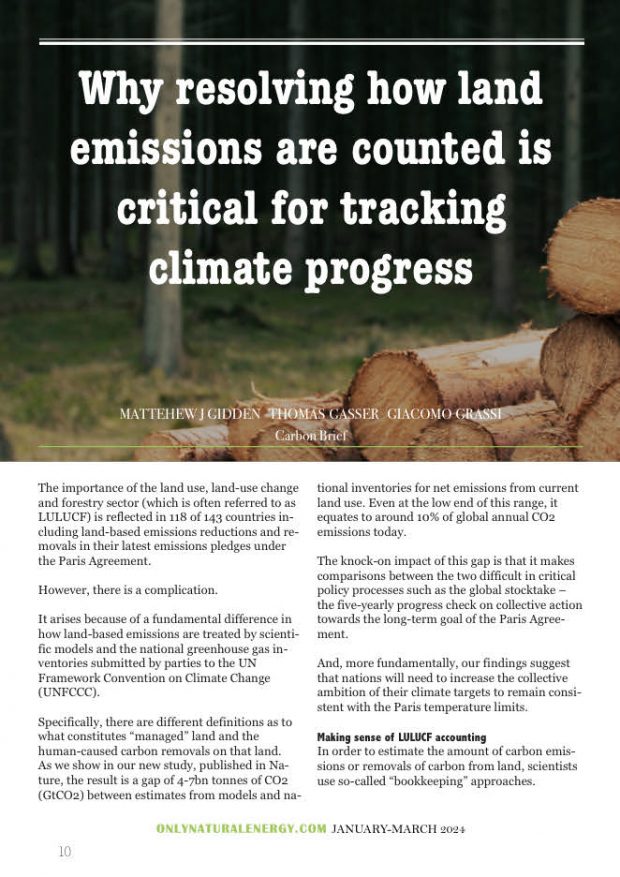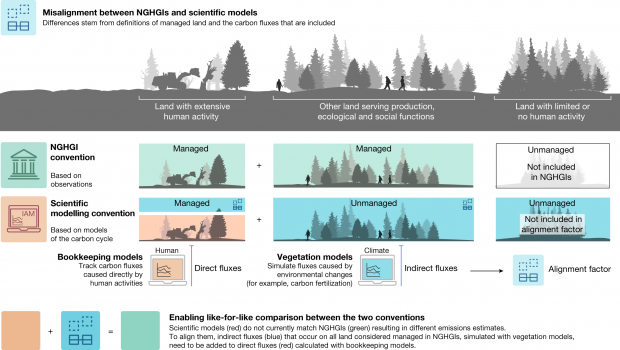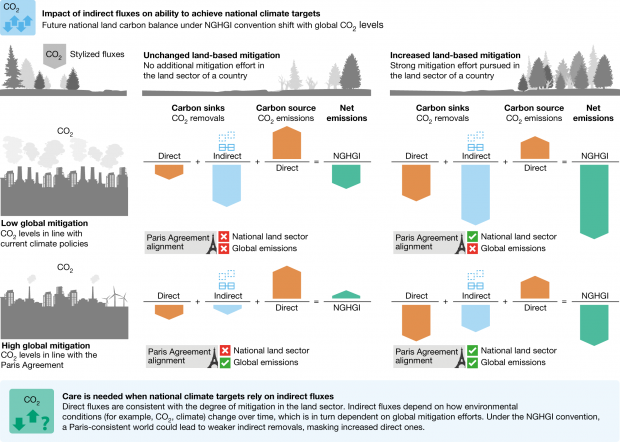 The importance of the land use, land-use change and forestry sector (which is often referred to as LULUCF) is reflected in 118 of 143 countries including land-based emissions reductions and removals in their latest emissions pledges under the Paris Agreement.
The importance of the land use, land-use change and forestry sector (which is often referred to as LULUCF) is reflected in 118 of 143 countries including land-based emissions reductions and removals in their latest emissions pledges under the Paris Agreement.
However, there is a complication.
It arises because of a fundamental difference in how land-based emissions are treated by scientific models and the national greenhouse gas inventories submitted by parties to the UN Framework Convention on Climate Change (UNFCCC).
Specifically, there are different definitions as to what constitutes “managed” land and the human-caused carbon removals on that land.
As we show in our new study, published in Nature, the result is a gap of 4-7bn tonnes of CO2 (GtCO2) between estimates from models and national inventories for net emissions from current land use. Even at the low end of this range, it equates to around 10% of global annual CO2 emissions today.
The knock-on impact of this gap is that it makes comparisons between the two difficult in critical policy processes such as the global stocktake – the five-yearly progress check on collective action towards the long-term goal of the Paris Agreement.
And, more fundamentally, our findings suggest that nations will need to increase the collective ambition of their climate targets to remain consistent with the Paris temperature limits.
Making sense of LULUCF accounting
In order to estimate the amount of carbon emissions or removals of carbon from land, scientists use so-called “bookkeeping” approaches.
These approaches, and the models that employ them, account for stocks and flows of carbon triggered by changes in land cover or land management practices and estimate the resulting “direct” carbon fluxes.
The term “direct” is used because the fluxes – that is, the exchange of CO2 between the land and atmosphere – are a result of direct human intervention. These actions, including deforestation, forest harvest and regrowth, are what scientific models consider as “anthropogenic” carbon fluxes.
This accounting approach is used by the models underpinning the concepts of the remaining carbon budget and net-zero timings in the assessment reports of the Intergovernmental Panel on Climate Change (IPCC).
But to understand the total amount of carbon flux on land, scientists need to use more detailed, process-based vegetation models. These models, collectively called “dynamic global vegetation models”, simulate biogeochemical and hydrological cycles and estimate future plant and forest carbon uptake and release.
These models explicitly include climate and environmental interactions and so they capture so-called “indirect” effects. These include the response of land to indirect human-induced climate and environmental changes, such as through CO2 fertilisation and warming-induced changes to temperatures and rainfall patterns, which affect plant growth.
These “indirect” fluxes are estimated for Earth’s full land surface area, including both land actively managed by humans as well as land with limited or no human activity in what global models consider as the “natural” terrestrial sink.
Taken together, both direct and indirect carbon fluxes on land provide a full picture of the land-related carbon balance, which is assessed each year by the Global Carbon Project.
However, countries estimate their LULUCF fluxes differently. This is because it is not practically possible to separate direct and indirect fluxes through observations, such as via national forest inventories or satellite data.
National GHG inventories follow reporting conventions that define human-caused fluxes using an area-based approach, whereby all fluxes occurring on managed land are considered anthropogenic. By contrast, fluxes on unmanaged land are not reported.
In addition to land that is actively managed for, say, agriculture and forestry practices, countries may consider other land as “managed”, such as national parks, wilderness preserves or areas under less frequent forest management.
But even if countries and models agreed on the amount of land which is considered “managed”, physical measurements and observations cannot distinguish between direct and indirect contributions to LULUCF fluxes.
As a result, national inventories include most of the indirect effect on a larger land area than is considered under scientific conventions. In short, countries consider “anthropogenic” part of the CO2 sink that models consider “natural”.
The infographic below outlines this mismatch. It shows how scientific models differentiate between direct (red) and indirect (blue) fluxes, while national inventories (green) do not.

Infographic illustrating how to align scientific models with national inventory definitions of LULUCF fluxes. Differences are due to what land is considered managed, and whether fluxes based on environmental and climatic changes are included. Source: Gidden et al. (2023)
Globally, this mismatch results in a difference between bookkeeping models and country inventories of around 4-7GtCO2. As the map below shows, the differences vary from country to country.
Overall, 53 and 56 countries report, respectively, LULUCF net removals (pale green shading) and emissions (purple) where models agree. Then 67 countries report net removals, but models suggest net emissions (dark green) and nine countries report net emissions while models show net removals (blue).
Shifting benchmarks
In our study, we propose a method for resolving these differences. We employ a reduced-complexity climate model called OSCAR, which has an explicit representation of the land carbon cycle. We use it to estimate the current and future evolution of indirect emissions to align IPCC pathways with aggregate estimates from national inventories.
We then estimate how this would affect mitigation benchmarks, such as the emissions reductions needed by 2030, the year of net-zero CO2 emissions and the total cumulative CO2 emitted until net-zero.
Across the board, we find that key global mitigation benchmarks become harder to achieve when calculated using conventions set in national inventories, requiring more ambitious mitigation action than when aiming for model-based outcomes.
For example, under inventory accounting conventions, we find that net-zero in emissions pathways that are consistent with 1.5C of warming is achieved one-to-five years earlier than in model-based conventions. Similarly, emissions reduction benchmarks this decade are three-to-six percentage points higher and cumulative CO2 emissions are 15-18% lower.
These shifts arise because of the additional land-based carbon removals in national inventories, or “alignment factor”, acts to lower current global emissions compared to model-based conventions. The alignment factor will diminish over time should the world succeed in reducing emissions drastically in the near-term.
IPCC assessment
It is important to stress that our results do not conflict with the benchmarks assessed by the IPCC.
The use of simple climate models, such as MAGICC and FaIR, in IPCC assessments includes the “direct” LULUCF emissions from pathways as inputs and include in their simulations the “indirect” emissions due to climate and environmental responses to calculate the global temperature response to human-caused emissions.
In our analysis, we explicitly separate these two flux components, adding the indirect fluxes on “managed” land to our estimate of the direct fluxes. In short, we simply align different accounting practices, shifting fluxes on one side of the “ledger” to the other.
The climate outcome of each scenario we assess remains the same, but the benchmark – when viewed through the lens of inventory accounting conventions – shifts. Understanding this dynamic is critical, because ultimately countries will measure their progress towards achieving the long-term temperature goal of the Paris Agreement against their own accounting conventions.
Our findings show the danger of comparing apples to oranges: in order to achieve the global mitigation benchmarks assessed by the IPCC, global mitigation action needs to be stronger and more ambitious when using the national inventories perspective.
While our adjustment does not change the overall amount of decarbonisation effort necessary to reach the Paris Agreement goal, it changes where we currently stand relative to it.
In the absence of such adjustment, countries would collectively appear in a better position than they actually are.
Depending heavily on LULUCF
Our results also provide a warning to countries depending strongly on the land sector to achieve their national climate pledges under the Paris Agreement.
From a bookkeeping accounting perspective, sustainable land-management practices can both strongly reduce existing sources of emissions as well as enhance land-based carbon removal.
Across pathways assessed by the IPCC, “direct” emissions typically reduce strongly and stay net-negative through the rest of the century. However, in the pathways we reanalyse, inventory-aligned emissions on land begin to reverse around mid-century and become a net source of emissions in about a quarter of the assessed pathways by the end of the century. This is because the weakening of the indirect effect contributes more than the strengthening of the direct effect in these scenarios.
While inventory-aligned fluxes result in smaller net emissions today compared to model-based fluxes, depending on them to achieve national climate targets presents a “double-edged sword”.
The indirect component of these fluxes is due to climate and environmental effects, which will change based on how strongly and quickly the world is able to reduce emissions in the future.
In particular, with high levels of mitigation, as the rate that CO2 accumulates in the atmosphere slows down, the strength of indirect fluxes will decrease and may even reverse.
Thus, countries should take care when depending strongly on the land sector as enhanced “direct” emissions reductions and removals can be masked by weakening “indirect” fluxes.
Other important factors which we did not consider could make depending on land-based removals even riskier, such as disturbances from wildfires, which will likely increase as the world continues to warm.
The graphic below provides an illustration. It shows the impact on direct (red) and indirect (blue) carbon emissions (up arrows) and removals (down) for scenarios with low (top) and high (bottom) global mitigation, and unchanged (left) and increased (right) land-based mitigation. The overall impact of each combination on net emissions is shown by the green arrows.

Figure showing how land-based removals (down arrows) can help or hinder achievement of national climate targets under unchanged (left) or increased (right) land-based mitigation, as well as low (top) or high (bottom) global mitigation action. Source: Gidden et al. (2023)
Moving forward
Our study highlights the importance of comparing apples to apples when trying to evaluate and take stock of progress towards the Paris Agreement.
Part of the core enabling architecture of the agreement was its “bottom-up” nature, enabling countries to set targets and measure progress towards them in such a way that fits national circumstances. At the same time, care must be taken to comparing these efforts with pathways assessed by the global scientific community.
Here, we offer one way to use the “Rosetta Stone” approach to align IPCC-assessed pathways with national emissions inventories, which can be used to assess progress in the near-term. We offer a number of recommendations for improving this moving forward.
First, we suggest that national climate targets can be made more explicit by separating targets for land-based mitigation from other sector-based action. In this way, each can be measured and assessed separately and uncertainties due to accounting differences can be contained.
Second, we suggest that countries can be more explicit and clarify their deforestation pledges, as direct and indirect carbon fluxes vary greatly in different forest types.
Third, we suggest that scientific and policymaking communities convene to agree on an “operational translation system”. That is, something that would allow each to understand the other by addressing any remaining inconsistencies and develop methods for estimating country-considered indirect fluxes to support comparison with modelled pathways.
And, fourth, we suggest that modellers incorporate their own estimates of the indirect effect from the land-component of their integrated models. Together with efforts by policymaking communities, this would bring alignment directly into IPCC reports to improve comparability with global progress towards the Paris Agreement.
Countries will come together at COP28 this year to conclude the very first global stocktake of the Paris Agreement.
Our assessment shows that even more ambitious climate action is needed to achieve the benchmarks laid out by scientists when using national inventory accounting as a starting point, which will help future stocktakes.
It is critical that progress is measured in a like-for-like manner rather than the current situation comparing apples and oranges.
Even so, the overarching message remains loud and clear that the world must drastically cut emissions this decade, irrespective of accounting frameworks, to stay within the limits of the Paris Agreement. It is vital this message is not lost in the minutia of discussions around reporting technicalities.
Originally published
by CarbonBrief
November 22, 2023





